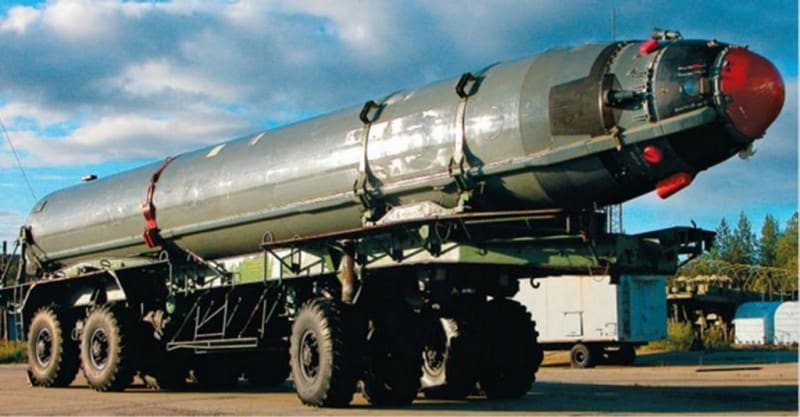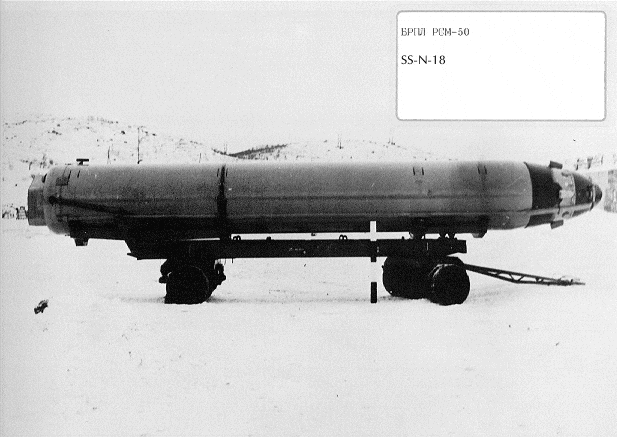The R-29 Vysota (NATO: SS-N-18 “Stingray”) is an intercontinental-range, submarine-launched, liquid-propellant ballistic missile. It likely derives from the SS-N-8 (R-29) missile. The SS-N-18 was designed for the Delta III ballistic missile submarine (SSBN), or Kalmar class. Each Kalmar carries sixteen SS-N-18 missiles.1
R-29 Vysota (SS-N-18 “Stingray”) at a Glance
- Originated from
- Russia
- Possessed by
- Russia
- Alternate names
- Stingray, R-29R Mod 1/2/3, Volna, D-9R, RSM-50, 3M40
- Class
- Submarine-launched Ballistic Missile (SLBM)
- Basing
- Submarine-launched
- Length
- 14.6 m
- Diameter
- 1.8 m
- Launch weight
- 35,300 kg
- Payload
- Three MIRV, 1,650 kg
- Warhead
- Nuclear 200 kT
- Propulsion
- Two-stage liquid propellant
- Range
- 6,500 km
- Status
- Operational
- In service
- 1977


SS-N-18 Development
There have been three SS-N-18 variants. Mod 1 has a range of 6,500 km, carries three MIRV warheads each equipped with a 200 kT nuclear yield. The Mod 2 variation carried a single 450 kT nuclear warhead to a range of 8,000 km. The Mod 3 variation carried seven MIRVed warheads, with a 6,500 km range. 2 They use an inertial guidance system coupled with a stellar sensor. The missiles use a two-stage, liquid-propellant engine. In 1991, all Mod 2 and Mod 3 versions were altered to the Mod 1 specifications.3
Development on the SS-N-18 began in 1968 and the missiles were first tested from land-based launch sites in 1975 and from a submarine in 1976. There have been over 150 tests since. The Mod 1 entered service in 1977, with the Mod 2 and Mod 3 entering in 1979.4
In 1991, 14 Delta III submarines remained in service, with only four still in service by July 2011. A 2013 U.S. report stated that there were 96 operational SS-N-18 missiles in Russia’s arsenal. 5
Replacement
As of 2016, 32 three-Mirved SS-N-18 missiles were deployed on two Delta III submarines, serving in Russia’s Pacific fleet. These are expected to be replaced by the Borei-class SSBNs, which will be equipped with SS-N-32 Bulava SLBMs.6
There was a proposal for the missile to be used as a Satellite Launch Vehicle (SLV) to be called Volyna. The SLV would have the capability to place a 130 kg payload into a 250 km (155 miles) circular orbit. Tests of the Volyna system have taken place in June 1995, July 2001 (unsuccessful), July 2002, June 2005 (unsuccessful), and October 2005.7
Footnotes
- “R-29R Volna (SS-N-18 ‘Stingray’/RSM-50/3M40),” in IHS Jane’s Weapons: Strategic 2015-2016, ed. James C. O’Halloran (United Kingdom: IHS, 2015), 89-90.
- [4. Pavel Podvig, ed., Russian Strategic Nuclear Forces (Cambridge: The MIT Press, 2001), 330.
- “R-29R Volna (SS-N-18 ‘Stingray’/RSM-50/3M40),” in IHS Jane’s Weapons: Strategic 2015-2016, ed. James C. O’Halloran (United Kingdom: IHS, 2015), 89-90.
- “R-29R Volna (SS-N-18 ‘Stingray’/RSM-50/3M40),” in IHS Jane’s Weapons: Strategic 2015-2016, ed. James C. O’Halloran (United Kingdom: IHS, 2015), 89-90.
- National Air and Space Intelligence Center, U.S. Air Force, “Ballistic and Cruise Missile Threat,” 2013, http://fas.org/programs/ssp/nukes/nuclearweapons/NASIC2013_050813.pdf
- Hans M. Kristensen & Robert S. Norris (2016) Russian nuclear forces, 2016, Bulletin of the Atomic Scientists, 72:3, 125-129
- “R-29R Volna (SS-N-18 ‘Stingray’/RSM-50/3M40),” IHS Jane’s Weapons: Strategic 2015-2016, ed. James C. O’Halloran (United Kingdom: IHS, 2015), 89-90.